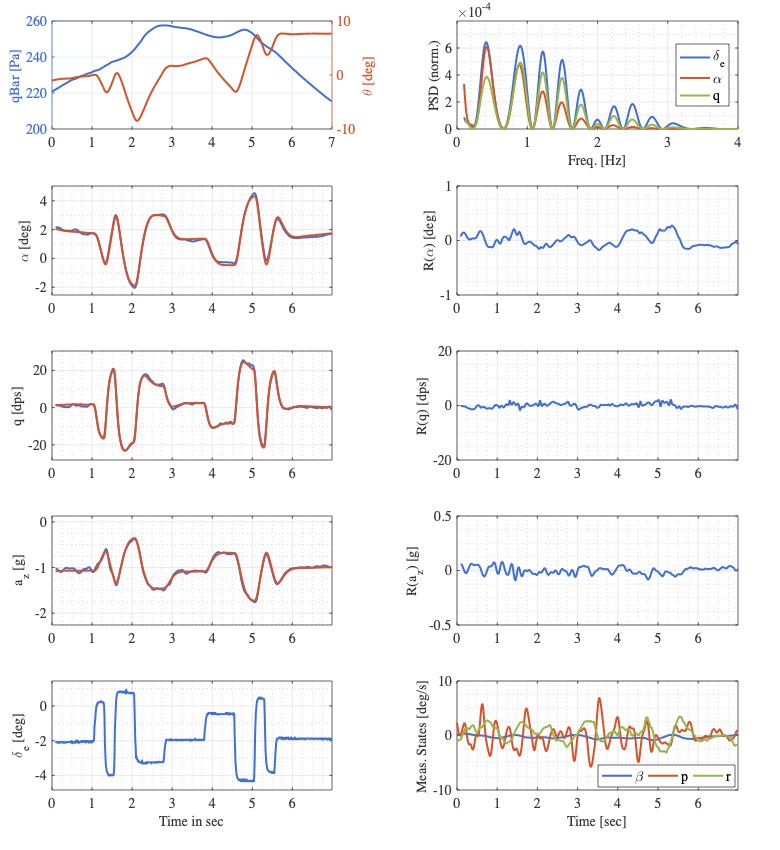UAVmainframe V5
A high performance instrumentation and control system for UAV flight test applications
Highlights

Longitudinal manoeuvre
Flight data vs. identified model
- In a very small package, it combines the power of an embedded Linux system with a reconfigurable , highly parallel real time capable computing architecture. The design allows for accurate sampling and processing of a large number of sensor channels (150+) at currently 100 Hz.
- Flight control algorithms can aid the pilot to precisely fly the required manoeuvres and an integrated control input generator can generate any waveform desired by the flight test engineer to excite the aircraft dynamics. Real time observations, monitoring and interaction is possible via the detailed telemetry link to the groundstation computer.
The system is easily configured for a particular airframe using simple text files, as well as via inflight changeable system parameters through the groundstation. The UAVmainframe is fully redundant and allows the test pilot to take over manual control at any time in case of an onboard failure or malfunction.
- The UAVmainframe has been successfully flown on aircraft of 2kg empty weight and above. It is suitable for fixed wing, multi-rotor and hybrid airframes, covering virtually the entire range of existing UAV designs. In addition, it can be used as a low cost, high performance flight test instrumentation system for general aviation applications.
- The system has been proven over 100+ flights on a small, fixed wing UAV, and operated without a single failure during these tests.
Applications
- Flight research and flight testing for UAVs and general aviation
- Education and training of flight test engineers
- Trusted autonomy research
- Health and usage monitoring
- Enables advanced control applications based on accurate system models generated with the UAVmainframe
- Enables fields of research that are too costly or dangerous to pursue with manned aircraft (aeroelasticity, damage tolerance, etc.) to be performed with (potentially expendable or parachute recovered) UAVs
Hardware Features
Hardware Features
- Linux/ARM based main flight computer, coupled with a network of realtime processors to enable 150+ sensor channels sampled at 100 Hz
- Small (100x80x60 mm) and light (250g incl. all wiring)
- Accurate, hardware synchronised sensor timing
- Expandable and re-configurable for virtually any kinds of sensors via expansion cards
- Standard ethernet/Wifi links for user interface and data transfer on the ground
- Long range telemetry radio for in- flight communications
- Hardware based control signal redundancy
True 50Hz update rate GPS receiver or RTK solutions
- Latest generation MEMS inertial sensors
- Control surface feedback sensors
- Flexible airdata sensors (standard air vanes and five hole probes)
- Versatile power, motor and battery monitoring capabilities
Software Features
Software Features
- Flight data acquisition optimised for accurate engineering data
- Flight control and management functionality
- Flight data acquisition optimised for accurate engineering data
- Flight control and management functionality
- Versatile onboard control waveform generation for system identification tasks
- Modular software architecture with installed sensors detected and configured automatically
- Quickly expandable for virtually any kinds of sensors
- Extended sensor calibration options
- Quaternion attitude control, works with any airframe configuration (under development)
- Works with the standard MAVlink telemetry protocol and the Qgroundcontrol groundstation
- Integrated hardware in the loop flight simulation for development and ground testing
- Longitudinal total energy control system (TECS)
- Performance flight testing features, such as constant speed glides, level accelerations and level turns
- Closed loop input execution with adaptive control strategies to enable identification of open loop dynamics while in closed loop control
- Powerful data analysis tools for post- flight analysis
Real time Extended Kalman Filter for sensor error correction of the flight control sensors
- Offline multi-pass Extended Kalman Filter for sensor error estimation/ correction and data compatibility checking to ensure the best possible data quality

